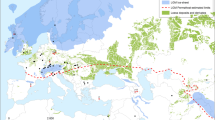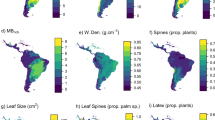Abstract
The Kentucky coffeetree (Gymnocladus dioicus, Fabaceae) is an ecological paradox. A rare tree in nature in eastern and central North America, G. dioicus produces legumes that are only known to be dispersed by water, but appear similar to fruits consumed and dispersed by elephants and rhinoceros. One would expect the pods to be consumed by livestock, but the pulp and seeds are toxic to cattle and sheep. We examine the puzzle of G. dioicus dispersal in light of its other reproductive and life history characteristics and find that it probably is a botanical anachronism, in terms of both a set of dispersal agents long extinct and habitats, including what we term megafaunal disclimaxes, which have disappeared. Large seeds, the megafaunal gestault of the fruit, a dioecious mating system, and shade-intolerance combined with vigorous cloning suggest a widely dispersed pioneer of Miocene through Pleistocene habitats profoundly altered by large-mammal herbivory. As to what ate it, we can only say there were once many candidates. We hypothesize that the plant is an ecological anachronism, sinking to extinction in the wild.
Similar content being viewed by others
References
Alexandre DY (1978) Le rôle disseminateur des éléphants en forét de tai, Côte d’Ivoire. Terre Vie 32:47–71
Alroy J (1999) The fossil record of North American mammals: evidence for a Paleocene evolutionary radiation. Syst Biol 48:107–118
Barlow C (2000) The ghosts of evolution: nonsensical fruit, missing partners, and other ecological anachronisms. Basic Books, New York
Barnes BV, Wagner WG, Otis CH (1981) Michigan trees: a guide to the trees of Michigan and the Great Lakes region. The University of Michigan Press, Michigan
Baskin CC, Baskin JM (1998) Seeds: ecology, biogeography, and evolution of dormancy and germination. Academic Press, San Diego
Beal WJ (1898) Some unique examples of dispersion of seeds and fruits. Am Midl Nat 32:859–866
Burrows GE, Tyrl RJ (2001) Toxic plants of North America. Iowa State University Press, Ames
Cipolinni ML, Levey DJ (1997) Secondary metabolites of fleshy vertebrate-dispersed fruits: adaptive hypotheses and implications for seed dispersal. Am Nat 150:346–372
Cochrane EP (2003) The need to be eaten: Balanites wilsoniana with and without elephant seed-dispersal. J Trop Ecol 19:579–589
Cordeiro NJ, Patrick DAG, Munisi B, Gupta V (2004) Role of dispersal in the invasion of an exotic tree in East African submontane forest. J Trop Ecol 20:449–457
Curtis JT (1959) The vegetation of Wisconsin: an ordination of plant communities. The University of Wisconsin Press, Madison
Davis MB (1986) Climatic instability, time lags, and community disequilibrium. In: Diamond J, Case TJ (eds) Community Ecology. Harper and Row, New York, pp 269–284
Deam DC (1921) Trees of Indiana. Fort Wayne Printing, Fort Wayne
Dinerstein E, Wemmer CM (1988) Fruits rhinoceros eat: dispersal of Trewia nudiflora (Euphorbiaceae) in lowland Nepal. Ecology 69:1768–1774
Dudley JP (2000) Seed dispersal by elephants in semiarid woodland habitats of Hwange National Park, Zimbabwe. Biotropica 32:556–561
Evans CS, Bell EA (1978) ‘Uncommon’ amino acids in the seeds of 64 species of Caesalpinieae. Phytochemistry 17:1127–1129
Evers RA, Link RP (1972) Poisonous plants of the Midwest. University of Illinois Press, Urbana
Farlow JO (1987) Speculations about the diet and digestive physiology of herbivorous dinosaurs. Paleobiology 13:60–72
Fritz H, Duncan P, Gordon IJ, Illius AW (2002) Megaherbivores influence trophic guilds structures in African ungulate communites. Oecologia 131:620–625
Gautier-Hion A, Emmons LH, Dubost G (1980) A comparison of the diets of three major groups of primary consumers of Gabon (primates, squirrels and ruminants). Oecologia 45:182–189
Gautier-Hion A, Duplantier JM, Quris R, Feer F, Sourd C, Decoux JP, Dubost G, Emmons LH, Erard C, Hecketsweiler P, Moungazi A, Roussilhon C, Thiollay JM (1985) Fruit characters as a basis of fruit choice and seed dispersal in a tropical forest vertebrate community. Oecologia 65:324–337
Graham RW, Lundelius EL Jr, Graham MA, Schroeder EK, Toomey RSIII, Anderson E, Barnosky AD, Burns JA, Churcher CS, Grayson DK, Guthrie RD, Harington CR, Jefferson GT, Martin LD, McDonald HG, Morlan RE, Semken HA Jr, Webb SD, Werdelin L, Wilson MC (1996) Spatial response of mammals to late quaternary environmental fluctuations. Science 272:1601–1606
Grime JP (1979) Plant strategies and vegetation processes. Wiley, New York
Guimaraes PR Jr, Galetti M, Jordano P (2008) Seed dispersal anachronisms: rethinking the fruits extinct megafauna ate. PLoS ONE 3(3):e1745
Guthrie RD (1984) Mosaics, allelochemicals and nutrients: an ecological theory of late pleistocene megafaunal extinctions. In: Martin PS, Klein RG (eds) Quaternary extinctions: a prehistoric revolution. University of Arizona Press, Tucson, pp 259–298
Hansen RM (1978) Shasta ground sloth food habits, Rampart Cave, Arizona. Paleobiology 4:302–319
Heilmann LC, de Jong K, Lent PC, de Boer WF (2006) Will tree euphorbias (Euphorbia tetragona and Euphorbia triangularis) survive under the impact of black rhinoceros (Biconris diceros minor) browsing in the Great Fish River Reserve, South Africa? Afr J Ecol 44:87–94
Herrera CM (1985) Determinants of plant-animal coevolution: the case of mutualistic seed-dispersal systems. Oikos 44:132–141
Herrera CM (2002) Seed dispersal by vertebrates. In: Herrera CM, Pellmyr O (eds) Plant–animal interactions: an evolutionary approach. Blackwell, Malden, pp 185–208
Hofreiter M, Poinar HN, Spaulding WG, Bauer K, Martin PS, Possnert G, Paabo S (2000) A molecular analysis of ground sloth diet through the last glaciation. Mol Ecol 9:1975–1984
Howe HF (1984) Constraints on the evolution of mutualisms. Am Nat 123:764–777
Howe HF (1985) Gomphothere fruits: a critique. Am Nat 125:853–865
Howe HF (1989) Scatter- and clump-dispersal and seedling demography: hypothesis and implications. Oecologia 79:417–426
Howe HF, Smallwood J (1982) Ecology of seed dispersal. Annu Rev Ecol Syst 13:201–228
Hughes L, Dunlop M, French K, Leishman MR, Rice B, Rodgerson L, Westoby M (1994) Predicting dispersal spectra: a minimal set of hypotheses based on plant attributes. J Ecol 82:933–950
Huxley AJ, Griffiths M (1992) The New Royal Horticultural Society dictionary of gardening. Stockton Press, New York
Jackson ST, Webb RS, Anderson KH, Overpeck JT, Webb TIII, Williams JW, Hansen BCS (2000) Vegetation and environment in eastern North America during the last glacial maximum. Quatern Sci Rev 19:489–508
Janis CM (1993) Tertiary mammal evolution in the context of changing climates, vegetation, and tectonic events. Annu Rev Ecol Syst 24:467–500
Janis CM, Damuth J, Theodor JM (2004) The species richness of Miocene browsers, and implications for habitat type and primary productivity in the North American grassland biome. Palaeogeogr Palaeoclimatol Palaeoecol 207:371–398
Janzen DH (1976) Effect of defoliation on fruit-bearing branches of the Kentucky coffee tree, Gymnocladus dioica (Leguminosae). Am Midl Nat 95:474–478
Janzen DH (1980) When is it coevolution? Evolution 34:611–612
Janzen DH, Martin P (1982) Neotropical anachronisms: what the gomphotheres ate. Science 215:19–27
Jordano P (1995) Angiosperm fleshy fruits and seed dispersers: a comparative analysis of adaptation and constraints in plant–animal interactions. Am Nat 145:163–191
Kinghorn AD (1979) Cocarcinogenic irritant Euphorbiaceae. In: Kinghorn AD (ed) Toxic Plants. Columbia University Press, New York, pp 137–160
Kingsbury JM (1964) Poisonous plants of the United States and Canada. Prentice-Hall, New Jersey
Konoshima T, Yasuda I, Kashiwada Y, Cosentino LM, Lee KH (1995) Anti-AIDS agents, 21. Triterpenoid saponins as anti-HIV principles from fruits of Gleditsia japonica and Gymnocladus chinensis, and a structure-activity correlation. J Nat Prod 58:1372–1377
Kurtén B, Anderson E (1980) Pleistocene mammals of North America. Columbia University Press, New York
Lindsey AA, Petty RO, Sterling DK, VanAsdall W (1961) Vegetation and environment along the Wabash and Tippecanoe Rivers. Ecol Monogr 31:105–156
Lindsey AA, Crankshaw WB, Qadir SA (1965) Soil relations and distributional map of presettlement Indiana. Bot Gaz 126:155–163
McClain ML, Jackson MT (1980) Vegetational associates and site characteristics of Kentucky coffeetree, Gymnocladus dioicus (L.) K. Koch Proc Central Hardwoods For Conf 3: 239–256
Murray DR (ed) (1986) Seed dispersal. Academic Press, Sydney
Oh CH, Mabry TJ, Kim KR, Kim JH (1995) GC–MS analysis of nonprotein amino acids in Gymnocladus dioica as N (O, S)-isobutyloxycarbonyl silyl derivatives. J Chromatogr Sci 33:399–404
Overpeck JT, Webb RS, Webb TIII (1992) Mapping eastern North American vegetation change over the past 18 ka: no-analogs in the future. Geology 20:1071–1074
Owen-Smith N (1987) Pleistocene extinctions: the pivotal role of megaherbivores. Paleobiology 13:351–362
Pan M, Bonness MS, Mabry TJ (1995) Non-protein amino acids from Gymnocladus dioica. Biochem Syst Ecol 23:575–576
Pirone PP (1978) Diseases and pests of ornamental plants, 5th edn. John Wiley and Sons, New York
Rosenthal GA (1991) Nonprotein amino acids as protective allelochemicals. In: Rosenthal GA, Berenbaum MR (eds) Herbivores: their interactions with secondary plant metabolites. The chemical participants, vol 1, 2nd edn. Academic Press, New York, pp 1–34
Sheil D, Salim A (2004) Forest tree persistence, elephants, and stem scars. Biotropica 36:505–521
Southon IW, Bisby F, Buckingham J, Harborne JB, Zarucchi JL (1994) Phytochemical dictionary of the Leguminosae, vol 1. Chapman & Hall, New York
Tehon LR, Morrill CC, Graham R (1946) Illinois plants poisonous to livestock. University of Illinois Press, Urbana
Tiffney BH (2004) Vertebrate dispersal of seed plants through time. Annu Rev Ecol Syst 35:1–29
Tiffney BH, Manchester SR (2001) The use of geological and paleontological evidence in evaluating plant phylogeographic hypotheses in the Northern hemisphere tertiary. Int J Plant Sci 162:S3–S17
van der Pijl L (1982) Principles of dispersal in higher plants, 3rd edn. Springer, Berlin
Van Soest PJ (1994) Nutritional ecology of the ruminant, 2nd edn. Cornell University Press, Ithaca
Webb SD (1983) The rise and fall of the Late Miocene ungulate fauna in North America. In: Nitecki MH (ed) Coevolution. University of Chicago Press, Chicago, pp 267–306
Werthner WB, Werthner EH, Kienholz AR (1935) Some American trees: an intimate study of native Ohio trees. Macmillian, New York
Wing SL, Tiffney BH (1987) The reciprocal interaction of angiosperm evolution and tetrapod herbivory. Rev Palaeobot Palynol 50:179–210
Acknowledgments
We thank Usama Ahmad, Luca Borghesio, Crystal Guzman, Maria Luisa Jorge, William Lu, Jennifer Ison, Andrea Kramer, Gabriela Nunez-Iturri, Manette Sandor, Carrie Seltzer, John Silander, Amy Sullivan, Bruce Tiffney, Mariana Valencia, Jenny Zambrano, and anonymous reviewers for comments on the manuscript. We gratefully acknowledge support from the Archbold Biological Station, the University of Illinois at Chicago, and the National Science Foundation (DEB 0129081, 0516259). Procedures conformed to federal, state and local laws and permit regulations.
Author information
Authors and Affiliations
Corresponding author
Additional information
Communicated by John Silander.
Rights and permissions
About this article
Cite this article
Zaya, D.N., Howe, H.F. The anomalous Kentucky coffeetree: megafaunal fruit sinking to extinction?. Oecologia 161, 221–226 (2009). https://doi.org/10.1007/s00442-009-1372-3
Received:
Accepted:
Published:
Issue Date:
DOI: https://doi.org/10.1007/s00442-009-1372-3




